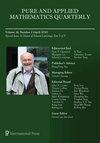Radiation and Asymptotics for Spacetimes with Non-Isotropic Mass
IF 0.8
4区 数学
Q3 MATHEMATICS
引用次数: 0
Abstract
We derive new results on radiation, angular momentum at future null infinity and peeling for a general class of spacetimes. For asymptotically-flat solutions of the Einstein vacuum equations with a term homogeneous of degree $-1$ in the initial data metric, that is it may include a non-isotropic mass term, we prove new detailed behavior of the radiation field and curvature components at future null infinity. In particular, the limit along the null hypersurface $C_u$ as $t \to \infty$ of the curvature component $\rho =\frac{1}{4}{R_{3434}}$ multiplied with $r^3$ tends to a function $P(u, \theta, \phi)$ on $\mathbb{R} \times S^2$. When taking the limit $u \rightarrow + \infty$ (which corresponds to the limit at spacelike infinity), this function tends to a function $P^+(\theta, \phi)$ on $S^2$. We prove that the latter limit does not have any $l=1$ modes. However, it has all the other modes, $l = 0, l \geq 2$. Important derivatives of crucial curvature components do not decay in $u$, which is a special feature of these more general spacetimes We show that peeling of the Weyl curvature components at future null infinity stops at the order $r^{-3}$, that is $(r^{-4}|u|^{+1}$, for large data, and at order $r^{-\frac{7}{2}}$ for small data. Despite this fact, we prove that angular momentum at future null infinity is well defined for these spacetimes, due to the good behavior of the $l=1$ modes involved.具有非各向同性质量的时空的辐射和渐近性
我们推导出了关于辐射、未来空无穷远处的角动量以及一般空间的剥离的新结果。对于爱因斯坦真空方程的渐近平直解,其初始数据度量中有一个度数为 $-1$ 的同质项,即可能包括一个非各向同性的质量项,我们证明了辐射场和曲率分量在未来空无穷远处的新的详细行为。特别是,当曲率分量$\rho =\frac{1}{4}{R_{3434}}$ 乘以$r^3$时,沿着空超表面$C_u$的极限在$t \to \infty$上趋于函数$P(u, \theta,\phi)$ on $\mathbb{R} \times S^2$。当取极限 $u \rightarrow + \infty$(对应于空间无穷大处的极限)时,这个函数趋向于 $S^2$ 上的函数 $P^+(\theta,\phi)$。我们证明后一极限不具有任何 $l=1$ 模式。然而,它具有所有其他模式,即 $l = 0, l \geq 2$。关键曲率分量的重要导数不在$u$中衰减,这是这些更一般的时空的一个特殊特征。我们证明,对于大数据,韦尔曲率分量在未来空无穷大处的剥离在$r^{-3}$阶停止,即$(r^{-4}|u|^{+1}$,而对于小数据,则在$r^{-\frac{7}{2}}阶停止。尽管如此,我们还是证明,由于所涉及的 $l=1$ 模式行为良好,这些时空在未来空无穷大处的角动量定义良好。
本文章由计算机程序翻译,如有差异,请以英文原文为准。
求助全文
约1分钟内获得全文
求助全文
来源期刊
CiteScore
0.90
自引率
0.00%
发文量
30
审稿时长
>12 weeks
期刊介绍:
Publishes high-quality, original papers on all fields of mathematics. To facilitate fruitful interchanges between mathematicians from different regions and specialties, and to effectively disseminate new breakthroughs in mathematics, the journal welcomes well-written submissions from all significant areas of mathematics. The editors are committed to promoting the highest quality of mathematical scholarship.

 求助内容:
求助内容: 应助结果提醒方式:
应助结果提醒方式:


